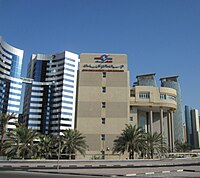Qatar Electricity and Water Company

Kahramaa's building in Doha, Qatar.
|
|
| Public | |
| Industry |
Energy Water |
| Founded | 2000 |
| Headquarters | Doha, Qatar |
|
Area served
|
State of Qatar |
|
Key people
|
Abdullah bin Hamad Al Attiyah (Chairman) |
| Products |
Electricity Water |
| Services | Utility provider |
| Website | www |
Kahramaa (Qatar General Electricity and Water Corporation), was established in July 2000 to regulate and maintain the supply of electricity and water for the population of Qatar. Since inception, Kahramaa has operated as an independent corporation on a commercial basis with a total capital of eight billion Qatari riyals. Kahramaa is the sole transmission and distribution system owner and operator for the electricity and water sector in Qatar.
During Qatar's years as a British protectorate in the 20th century, water and electricity was regulated by the British under two separate entities known as the State Electricity Department and the State Water Department. After the British announced their plans of withdrawing from the country in 1968, the state established the Ministry of Electricity and Water to regulate its electricity and water needs. In July 2000, the Qatar General Electricity and Water Corporation (Kahramaa) was established by emiri decree in order to regulate and maintain the supply of water and electricity for the Qatari population.
In August 2015, the company announced that it would begin construction of Umm al Houl Power, a desalination and power plant in the south of the country. The construction is estimated to cost around $2.75 billion and will have a capacity of 2520 MW and 136 million imperial gallons (620,000 m3) of potable water a day.
Qatar's first major solar power plant was announced by Kahramaa in 2014, and is slated to begin operations by 2016. Its production capacity is expected to be 15 MW. In December 2015, the company stated that it had signed an agreement with Qatar Petroleum for cooperation in the development of solar power plants. Kahramaa would retain 60% ownership of the plants constructed under the agreement, while Qatar Petroleum would retain the remaining 40%.
As of 2011, the electricity transmission networks consist of approximately 247 primary high voltage sub-stations. The network is coupled with 10500 low and medium voltage sub-stations (11 kV). Its voltage sub-stations are supported by a total 4000 km of overhead lines and 8,500 kilometres (5,300 mi) of underground cables running across the country. The National Control Center manages all network demand and data acquisition from generation plants and primary sub-stations.
Generation of electrical energy in Qatar has increased over the past fifty years; the maximum load over the network during the period from 1988 to 2003 has risen from 941 MW to 2,312 MW. It reached 3,230 MW in 2006. By 2011, it had increased to 6,518 MW. The company was producing around 8,600 MW by 2014; a 2,000 MW surplus when compared to the 6,600 MW of demand.
...
Wikipedia
